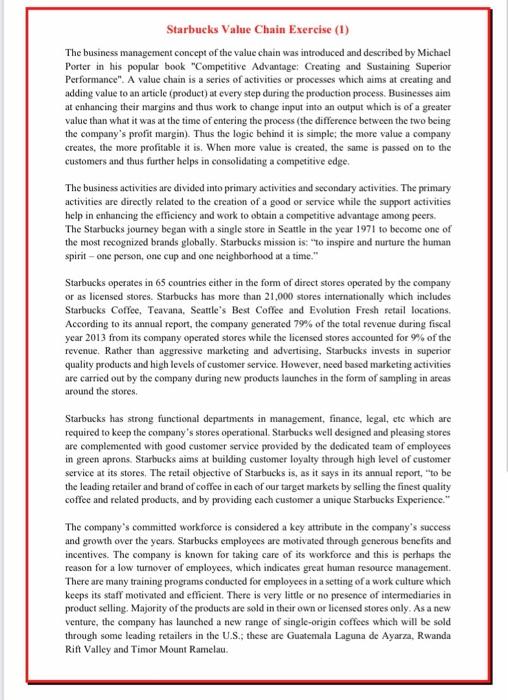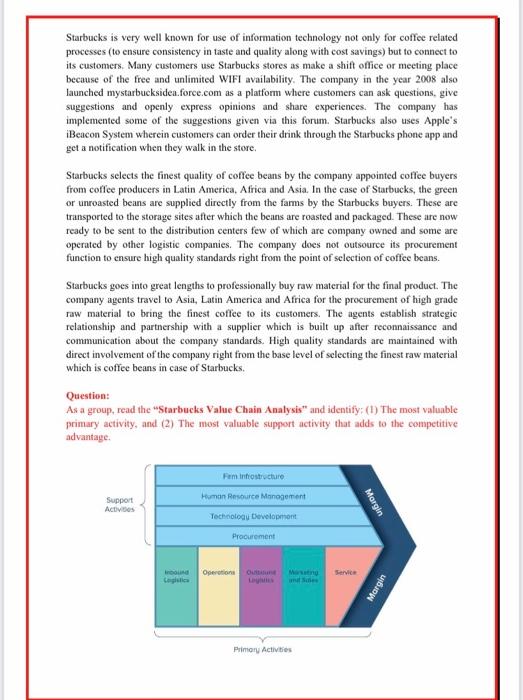Starbucks Value Chain Exercise (1) The business management concept of the value chain was introduced and described by Michael Porter in his popular book "Competitive Advantage: Creating and Sustaining Superior Performance". A value chain is a series of activities or processes which aims at creating and adding value to an article (product) at every step during the production process. Businesses aim at enhancing their margins and thus work to change input into an output which is of a greater value than what it was at the time of entering the process (the difference between the two being the company's profit margin). Thus the logic behind it is simple: the more value a company creates, the more profitable it is. When more value is created the same is passed on to the customers and thus further helps in consolidating a competitive edge. The business activities are divided into primary activities and secondary activities. The primary activities are directly related to the creation of a good or service while the support activities help in enhancing the efficiency and work to obtain a competitive advantage among peers. The Starbucks journey began with a single store in Seattle in the year 1971 to become one of the most recognized brands globally. Starbucks mission is to inspire and nurture the human spirit - one person, one cup and one neighborhood at a time." Starbucks operates in 65 countries either in the form of direct stores operated by the company or as licensed stores. Starbucks has more than 21,000 stores internationally which includes Starbucks Coffee, Teavana, Seattle's Best Coffee and Evolution Fresh retail locations. According to its annual report, the company generated 79% of the total revenue during fiscal year 2013 from its company operated stores while the licensed stores accounted for 9% of the revenue. Rather than aggressive marketing and advertising, Starbucks invests in superior quality products and high levels of customer service. However, need based marketing activities are carried out by the company during new products launches in the form of sampling in areas around the stores Starbucks has strong functional departments in management, finance, legal, etc which are required to keep the company's stores operational. Starbucks well designed and pleasing stores are complemented with good customer service provided by the dedicated team of employees in green aprons. Starbucks aims at building customer loyalty through high level of customer service at its stores. The retail objective of Starbucks is, as it says in its annual report, "to be the leading retailer and brand of coffee in each of our target markets by selling the finest quality coffee and related products, and by providing each customer a unique Starbucks Experience." The company's committed workforce is considered a key attribute in the company's success and growth over the years. Starbucks employees are motivated through generous benefits and incentives. The company is known for taking care of its workforce and this is perhaps the reason for a low turnover of employees, which indicates great human resource management, There are many training programs conducted for employees in a setting of a work culture which keeps its staff motivated and efficient. There is very little or no presence of intermediaries in product selling. Majority of the products are sold in their own or licensed stores only. As a new venture, the company has launched a new range of single-origin coffees which will be sold through some leading retailers in the U.S., these are Guatemala Laguna de Ayarza, Rwanda Rift Valley and Timor Mount Ramelau. Starbucks is very well known for use of information technology not only for coffee related processes to ensure consistency in taste and quality along with cost savings) but to connect to its customers. Many customers use Starbucks stores as make a shift office or meeting place because of the free and unlimited WIFI availability. The company in the year 2008 also launched mystarbucksidea.force.com as a platform where customers can ask questions, give suggestions and openly express opinions and share experiences. The company has implemented some of the suggestions given via this forum. Starbucks also uses Apple's iBeacon System wherein customers can order their drink through the Starbucks phone app and get a notification when they walk in the store. Starbucks selects the finest quality of coffee beans by the company appointed coffee buyers from coffee producers in Latin America, Africa and Asia. In the case of Starbucks, the green or unroasted beans are supplied directly from the farms by the Starbucks buyers. These are transported to the storage sites after which the beans are roasted and packaged. These are now ready to be sent to the distribution centers few of which are company owned and some are operated by other logistic companies. The company does not outsource its procurement function to ensure high quality standards right from the point of selection of coffee beans. Starbucks goes into great lengths to professionally buy raw material for the final product. The company agents travel to Asia, Latin America and Africa for the procurement of high grade raw material to bring the finest coffee to its customers. The agents establish strategic relationship and partnership with a supplier which is built up after reconnaissance and communication about the company standards. High quality standards are maintained with direct involvement of the company right from the base level of selecting the finest raw material which is coffee beans in case of Starbucks. Question: As a group, read the Starbucks Value Chain Analysis and identify: (1) The most valuable primary activity, and (2) The most valuable support activity that adds to the competitive advantage Support Active Fem inostructure Human Resource Management Technolo Development Procurement Morgin Operational Margin Primary Activities








